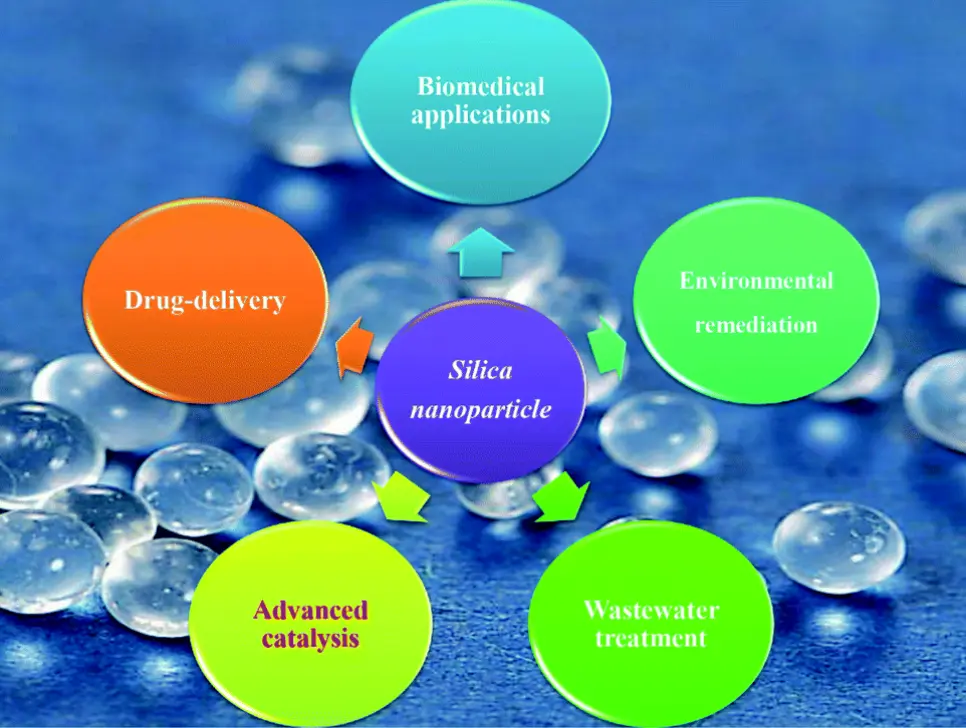
The Importance of Silica Nanoparticles
Silica nanoparticles (SiO₂ NPs) have emerged as one of the most versatile and widely used nanomaterials due to their unique properties, tunable size, and high biocompatibility. Their applications span across multiple industries, including medicine, environmental protection, electronics, and cosmetics, making them integral to advancing various technological innovations as shown in the figure [1]:

Biomedical Applications:
One of the most significant areas where silica nanoparticles have had an impact is in biomedicine, particularly in drug delivery systems, bioimaging, and diagnostics.
Drug Delivery: Silica nanoparticles are excellent carriers for drug molecules because of their porous structure, large surface area, and ability to be functionalized. The surface of silica nanoparticles can be modified to attach therapeutic agents, allowing for targeted and controlled drug release. This has proven beneficial in delivering chemotherapy drugs directly to tumor cells, minimizing side effects to healthy tissue [2].
Bioimaging and Diagnostics: Silica nanoparticles can be engineered to carry imaging agents for techniques like MRI or fluorescence imaging. Due to their small size, they can penetrate biological barriers and provide detailed images of internal organs, tissues, and cells. This enhances the early detection of diseases and helps in monitoring treatment progress [3].
Environmental Applications:
Silica nanoparticles also play an important role in addressing environmental challenges. Their high surface area and tunability make them ideal for use in water treatment and pollution control.
Water Purification: Functionalized silica nanoparticles can be used to remove contaminants such as heavy metals, organic pollutants, and pathogens from water sources. They can also be employed in filters or as absorbents to improve water quality, offering an effective solution to pollution [4].
Air Pollution Control: Silica nanoparticles can be incorporated into air filters or coatings to trap harmful particles and gases, contributing to cleaner air in industrial and urban environments [5].
Catalysis and Chemical Synthesis
In the field of catalysis, silica nanoparticles serve as support for catalysts used in chemical reactions. Their high surface area and porosity allow for efficient catalyst dispersion, which enhances the rate of reactions.
Energy Production: Silica nanoparticles are employed in catalytic processes for the production of renewable energy sources such as hydrogen. Their use in fuel cells and other energy-related applications is vital for the development of sustainable energy solutions [6].
Green Chemistry: Silica-supported catalysts help reduce the need for harsh chemicals and extreme reaction conditions, aligning with the principles of green chemistry and sustainable industrial practices [7].
Electronics and Nanotechnology:
The electronic industry relies on silica nanoparticles for a range of applications, including coatings, sensors, and electronic components.
Coatings and Insulation: Silica nanoparticles are used in the production of insulating materials, especially in electronics, where they protect sensitive components from heat and corrosion. Their small size and stability under high temperatures make them ideal for protective coatings in electronic devices [8].
Sensors: Silica nanoparticles are integral to the development of highly sensitive sensors for detecting gases, chemicals, and biomolecules. These sensors are used in everything from medical diagnostics to environmental monitoring, providing precise and accurate readings at very low concentrations [9].
Conclusion:
Silica nanoparticles have proven to be an indispensable material in numerous fields due to their versatility, ease of surface modification, and biocompatibility. Whether in healthcare, environmental protection, personal care, or industrial applications, silica nanoparticles offer solutions to complex challenges and continue to drive innovation across industries. Their importance is expected to grow as new applications and technologies emerge, cementing their role as a fundamental nanomaterial in modern science and technology.
References:
- [1] Nayl, A. A., Abd-Elhamid, A. I., Aly, A. A., & Bräse, S. (2022). Recent progress in the applications of silica-based nanoparticles. RSC advances, 12(22), 13706-13726.
- [2] Makhadmeh, G. N., Abuelsamen, A., Al-Akhras, M. A. H., & Aziz, A. A. (2022). Silica Nanoparticles Encapsulated Cichorium Pumilum as a Promising Photosensitizer for Osteosarcoma Photodynamic Therapy: In-vitro study. Photodiagnosis and Photodynamic Therapy, 38, 102801.
- [3] Vivero-Escoto, J. L., Huxford-Phillips, R. C., & Lin, W. (2012). Silica-based nanoprobes for biomedical imaging and theranostic applications. Chemical Society Reviews, 41(7), 2673-2685.
- [4] Yehia, H. M. A. S., & Said, S. M. (2023). Silica Nanoparticles for Water Purification and Monitoring in Point-of-Use Water Supply Systems. American Journal of Water Resources, 11(3), 98-102.
- [5] Yang, X., Shen, Z., Zhang, B., Yang, J., Hong, W. X., Zhuang, Z., & Liu, J. (2013). Silica nanoparticles capture atmospheric lead: implications in the treatment of environmental heavy metal pollution. Chemosphere, 90(2), 653-656.
- [6] Adebisi, J. A., Agunsoye, J. O., Bello, S. A., Ahmed, I. I., Ojo, O. A., & Hassan, S. B. (2017). Potential of producing solar grade silicon nanoparticles from selected agro-wastes: A review. Solar Energy, 142, 68-86.
- [7] Nandanwar, R., Singh, P., & Haque, F. Z. (2013). Synthesis and properties of silica nanoparticles by sol-gel method for the application in green chemistry. Material Science Research India, 10(1), 85-92.
- [8] Olivieri, F., Castaldo, R., Cocca, M., Gentile, G., & Lavorgna, M. (2021). Mesoporous silica nanoparticles as carriers of active agents for smart anticorrosive organic coatings: a critical review. Nanoscale, 13(20), 9091-9111.
- [9] Castillo, R. R., Baeza, A., & Vallet-Regí, M. (2017). Recent applications of the combination of mesoporous silica nanoparticles with nucleic acids: development of bioresponsive devices, carriers and sensors. Biomaterials science, 5(3), 353-377.




